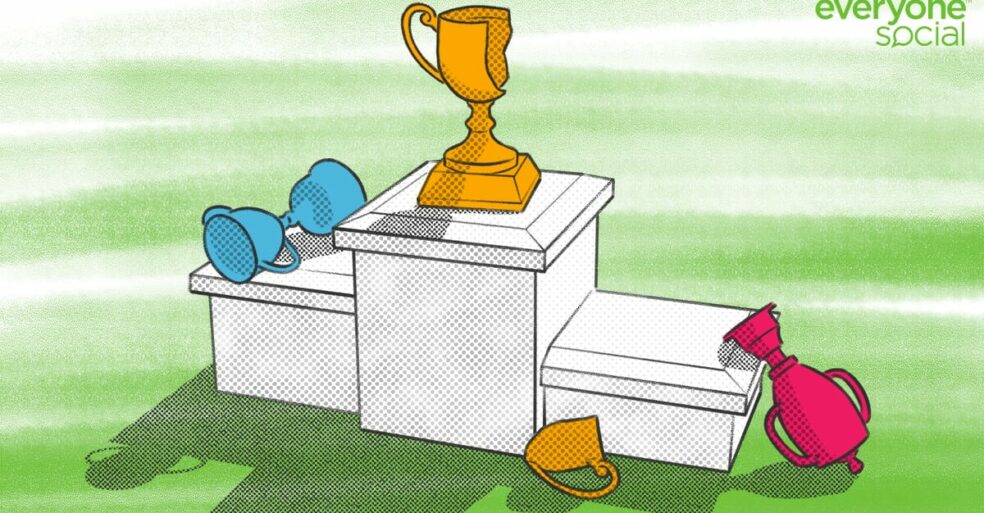Typically in many software products, gamification becomes a key product element to entice users to take some sort of action consistently.
This might be to improve marketing results, increase employee engagement, help product retention, etc.
While gamification can be a great product feature, many organizations like to lead with it to entice employees to use it more. This is especially true with employee advocacy platforms.
But leading with gamification to get your team social sharing and more involved is actually a mistake.
Here is what is what I’m going to cover:
- Why Leading with Gamification is a Mistake
- Gamification in Employee Advocacy Isn’t All Bad
- Avoid the STP Principle on the Leaderboard
Why Leading with Gamification is a Mistake
Your employee advocacy program is only going to be as successful as your employees’ engagement. And many companies will often turn to gamification to increase user engagement.
While gamification can certainly enhance engagement and has its place in employee advocacy, it shouldn’t be the driving force.
Instead, let’s call gamification what it really is: a performance enhancing drug.
Here are some reasons leading with gamification is a mistake to your social program.
Authenticity is Lost
Looking at employee advocacy purely from a “points” perspective removes the authenticity. Your organization’s social program is only being used because of incentive of points or prizes. Which goes into my next point…
Employees Are sharing for the Wrong Reasons
When you or your employee advocacy program admin leads with (or wants to lead with) gamification, employees tend to only share for the wrong reasons.
They share or actively use the platform strictly because they are mostly gamified, not because they care and want to be involved (socially).
The Interest in Points Fades
While at first you may seem some strong results, the points system starts to get old. Users grow tired of the “game” or stop caring about being the top of the leaderboard.
Eventually, people drop off, stop logging in, and share less often. Which leaves your organization seeing employee advocacy as a fail or something that does not provide value.
Leaderboard Positions Can Lead to Disenfranchisement
There will always be a few people who love reaching to the top of the leaderboard in a social program. Thus accumulating some serious deltas in points.
But leaderboard positions can lead to disenfranchisement of people who might otherwise participate (that one person CRUSHING the rest of the group by thousands of points).
So why bother even getting involved? We’ve seen this in the past.
Leading With Gamification Can Trigger Spamming
Back to those “slayers of the leaderboard.” When leading with a traditional leaderboard points system, this can quickly lead to employees spamming their social networks.
This is not employee advocacy!
You’ll find people sharing as much and as often as possible, with their only goal to be the leader and get whatever incentive you might be offering.
The only *real* way to make employee advocacy work long-term is to help users see personal benefits (like grow their own networks, help their voices be heard, create more career opportunities, influence real conversations).
As I mentioned earlier, gamification should enhance user engagement, not drive it.
Related: Looking for some other employee advocacy mistakes to avoid? Here are the seven sins of social programs to avoid.
Gamification in Employee Advocacy Isn’t All Bad
Sure, it sounds like I was pretty harsh on the concept of gamification.
But, myself and team at EveryoneSocial do not think having some gamified experience is all bad. We have written a bit on this topic before and there are some interesting statistics out there as it relates to gamifying business.
However, we’ve had prospects and clients in the past where gamifying is what really mattered most to their social strategy.
Yet, those who trudged forward by leading with gamification, quickly found their program and results lacking for many of the reasons we mentioned above.
Traditional leaderboards are setup to gamify and incentivize the activities that benefit the brand over the user. If your program is claiming to be rooted in the employees’ best interest (it should be!), then this seems inauthentic.
While you want your organization to benefit, you have to value the benefits for employees and show them what they will gain by getting involved in an employee advocacy program.
Gamifying can enhance those results, but cannot be the only factor to success.
Tips to Avoid the STP Principle on the Leaderboard
Gamification is certainly still a nice add-on feature to have and can boost results when done correctly. Our platform includes gamification and a leaderboard, but we caution organizations to be careful how it is used.
Below are some essential tips to avoid the “STP Principle” on the leaderboard (STP = same ten people).
1. Switch up how points are awarded:
Keep the gamification process and point tallies fresh, that way it keeps employees interested and lets others have a chance.
2. Zero-out the points for shares:
Traditionally in employee advocacy programs, shares have a weighted value for the leaderboard. It’s okay to do this, but a great way to mix it up and avoid employees potentially spamming, is to only award points for engagements or comments.
It removes spamming social networks and puts value on employees actually caring, showing interest, and engaging with their internal work community.
3. Recognize platform and program behaviors instead:
Typically, program admins will look at the leaderboard and just pick first place or maybe the top three. But gamification should go beyond that.
Recognize and reward other program moments like logins, articles read, frequent user, most network growth. Go beyond the “this person has the top points because of sharing the most” mindset.
4. Take the longview:
In any group of people, there are going to be those that relish competition and those that do not. One of the chief things to avoid when it comes to gamification is going too deep with the leaderboard too early.
Make sure that whatever you do is appropriate for the audience longterm and not going to be a one-and-done program.
5. Don’t overemphasize fancy rewards:
Thinking that people will only participate in your program if the rewards are big and flashy is a fallacy. Doing this often creates false incentives and people end up cutting corners and doing things you don’t want them to just to win.
Not all rewards need to be monetary or materialistic either. Some of the best gamification rewards we’ve seen are those that are connected with professional recognition and advancement.
6. Don’t just celebrate the top performer:
Performance should be measured at least in part based on participation. If 90% of your participants are fully engaged in your program (whatever it is), that’s a huge win, regardless if the top 10% are driving the majority of the results.
Gamification in employee advocacy is about the team.
Yes, you should reward your very top performer, but be careful to reward your participators as well. If you don’t, you’ll likely see a big drop off in engagement.
Final Thoughts
When it comes to your employee advocacy program, leading with gamification is a social blunder. Sure it might work early on for a bit, but you’ll quickly realize the negative impact it can have.
Yes, there are certainly positives to having a leaderboard or reward system, but you need to find the right balance.
As you read above, you’re doing a disservice to your employee advocacy program, your organization, and employees when the entire emphasis is on gamification.
Over the years, we have found and learned exactly how gamifying can enhance your social program, without being detrimental in the long run.
You and your organization want longterm success that delivers authenticity, which is exactly what happens when you do not lead with gamification.
















